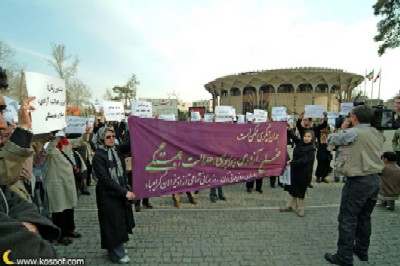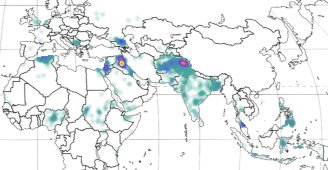In the United States, the institutions most similar to those of the Soviet Union are the DMV and the local Department of Social Services. I’ve been in both of them, and, believe me, it’s a toss-up as to which is more Soviet-like.
The dirty utility carpet… interminable waits on hard chairs… bored, indifferent, and condescending bottom-level bureaucrats… the return to the end of the line after a slight error in the paperwork.
We’ve all been there, and we all do the best we can to keep from going back.
So it was with some trepidation that I opened the website of the National Association of Social Workers in order to read the national study of the social work labor force that was released today. When the slickly-designed page finally loaded, I felt a special twitch of revulsion at the graphic on top: “NASW…the power of social work.” It was enough to make me want to close the window and forget it, but duty calls. Neither snow, nor rain, nor gloom of night, nor Socialism, can stay the blogger from his appointed rounds.
So I started to read the report.
Well, surprise, surprise! The NASW study had concluded that Americans are doing so well that social workers are scarcely necessary any longer, and the organization’s task from now on would be to help its members find gainful employment in other professions.
Just kidding. Here’s how the report opened:
Landmark Study Warns of Impending Labor Force Shortages For Social Work Profession
Services to Millions Threatened
[Washington, DC] [March 8, 2006] – At a news conference today, the National Association of Social Workers (NASW) released the results of a national study of licensed social workers. The findings warn of an impending shortage of social workers that threaten future services for all Americans, especially the most vulnerable among us, children and older adults.
“From adoption to geriatrics, hundreds of thousands of social workers in the United States play a critical role in the lives of millions of Americans,” says Tracy Whitaker, director of the NASW Center for Workforce Studies. “The findings of this study emphasize the need to assure a qualified social work labor force for the future. Predicted changes in the country’s demographics over the next years are expected to increase the demand for social work services.”
Didn’t expect that, did you? An organization dedicated to advancing the interests of social workers concludes that… (drum roll)… we need more social workers!
And we baby boomers are the main reason for the coming crunch:
The number of new social workers providing services to older adults is decreasing, despite projected increases in the number of older adults who will need social work services. Social workers provide valuable services to older adults and their families. They help clients to negotiate the healthcare and social welfare systems, to provide resources essential to living and to address the challenges that come with aging. With the aging of the baby boom generation and breakthroughs in medicine contributing to longer life spans, the number and percentage of Americans 60 years of age and older will surge. The need and demand for social work services for the aging will increase dramatically.
The report doesn’t mention that the morphing of the boomer baby into the boomer geezer is accompanied by a singular lack of children in the next generation. Come to think of it, social workers have played a part in that, too – over the last couple of generations they have been busy handing out condoms, counseling abortion, and providing incentives for people to depend on the state instead of their families. Europe is much worse off in that regard than we are, but we’ve got the same disease.
Do you think a social worker ever advised young people to marry and have children in order to guarantee their social welfare in old age?
I’m cynical, but it seems that the recommendations of social workers tend to lead to outcomes that require more social workers.
Oh, I know there are dedicated people in social work, in addition to the time-servers, the squabbling bureaucrats, the meddlers, and the little Stalins. But the social work racket is a system, and, regardless of the intentions of any of the people who act as its components, its only function is to protect its position and grow larger.
And that means that all of us will end up needing more social workers.
The NASW certainly highlights that theme:
Agencies struggle to fill social work vacancies. In all areas of social work practice, unfilled vacancies were an issue. Agencies have resorted to outsourcing and hiring non-professional staff to fill empty slots, an indicator of current labor market supply deficits. Because more than half of health care social workers work in hospitals in metropolitan areas, an additional challenge is to provide comprehensive services to people living in rural areas.
“Social workers are one of the largest and most diverse health professions in the United States,” says Dr. Elizabeth Clark, executive director of NASW. “They have the education and training to look at how all factors in a person’s life – family, work, health and mental health – work together. This study highlights the need to find new and innovative ways for the social work profession to retain the current workforce and recruit new social workers to accommodate the impending demand.”
It’s a good thing they’re there to take care of our children and old people, isn’t it? We certainly can’t do it without their help.
But there was a time when Americans got along without social workers. They somehow managed to give birth, raise their children, make a living, and take care of their elderly, all without help from Social Services. How was that possible?
Maybe that’s why we live longer these days, though I ascribe that more to penicillin, better nutrition, and blood-pressure medication than the actions of the good people down at the Jefferson Area Board for the Aging.
All of this made me wonder how much the social service industry has grown since FDR started the ball rolling back in the ’30s. I started googling, and ran into an alphabet soup of social workers’ professional organizations – local chapters of the NASW, the state organizations, groups fighting for the interests of LCSWs or MSWs. The census had current figures for the field, but I could find no historical data to speak of.
I did, however, run into this interesting little tidbit, “Social Security, Social Workers, and the Care of Dependent Children”, at a University of California at Irvine website:
Thus, since the early 1930s the number of social workers in the United States increased rapidly, climbing from 30,500 in 1930 to 60,000 in 1938 to 125,000 in 1965 to 263,000 in 1972. In addition, the amount of public funding available to support social services, and social workers also increased. At the same time, the number of orphans in the U.S. fell. Some orphaned and many needy children remained, however, and these were increasingly placed with foster-care families rather than in institutions. Social workers had, from the beginning of this century, expressed a strong preference for foster care over institutional care – a preference that we suggest was at least as much a product of social-workers’ concerns for their own professional status (and income) as it was of their concern for children’s welfare.
My emphasis.
So all of these myriad organizations of social workers – all those armies of the righteous dedicated to the cause of making you a better, more well-rounded, more culturally aware and diverse genetic entity – all of them owe their livelihoods to your tax dollars, either directly, through the appropriations for Social Services departments, or indirectly through the semi-governmental health care organizations and hospitals.
And what are they pooling their dollars to do, when they pay dues to the NASW? Raise their pay and protect their perks, right?
Well, there’s a little bit more than that. On the sidebar of the NASW site you’ll notice a menu. When your mouse pointer hovers over an choice called “Advocacy”, a little sub-menu pops up with these choices:
- ANSWER
- Government Relations Updates
- Grassroots Advocacy
- Legislative Issues
- Political Action for Candidate Election
- Register to Vote
That’s an interesting list, isn’t it? Don’t worry, ANSWER isn’t what you think; it’s “The Action Network for Social Work Education and Research.” But “grassroots advocacy”… Hmm. And “legislative issues” means “lobbying”, I presume.
And “candidate election” – how many of those candidates do you think are Republicans?
This is what your tax dollars buy: a group that advocates for left-wing issues, lobbies to protect itself and expand its turf, and helps elect candidates who further these ends.
Definitely a Soviet style of doing business.
So as we boomers age, and more and more social workers have to be inducted, where’s the additional funding going to come from? I’ll give you three guesses.
Or you can read this manifesto from the Massachusetts chapter of the NASW, Social Workers for Peace and Justice (SWPJ):
The Massachusetts Chapter’s commitment to social and economic justice is carried out in part by its very active Social Workers for Peace and Justice committee (SWPJ) which is located in the Pioneer Valley-Northampton-Amherst area. The Committee was begun in 1982, then as Social Workes [sic] for Peace and Nuclear Disarmamentm [sic] and has since played a key role in the Massachusetts peace and justice movement.
The ongoing mission of SWPJ has been towork [sic] for world peace, advocate for a smaller, more realistic defense budget and using these funds to meet human needs, and educate social workers and the public about the connections between the excessive military budget and the economic and social conditions in Massachusetts.
From the defense budget. Of course!
We’re going beat our swords into wheelchairs and turn our spears into nursing homes, that’s what we’re going to do.
One way or another, you’ll learn to love Big Sister.
 Update:
Update: A reader sent us this link to (
*** WARNING *** R-rated material at the other end of this link!)
a post by a social worker who finally snapped.


 That was then. This is now, and now includes Saudi Arabia’s hosting of a meeting in Jidda, from March 13-15th . This “summit” has been called specifically to focus on strengthening the Islamic economic boycott of Israel. You see, Saudi Arabia is not only a member of the WTO. It is also a member of the Organization of the Islamic Conference, the OIC. This dreary group has been in existence since forever. First founded as the Arab League — in 1949 when it was frightened by the appearance of Jews on its doorstep — and then later, in 1969 after its military humiliation at the hands of said Jews, it morphed into an organization to include all Islamic states, not just those in Arabia. Here’s what their
That was then. This is now, and now includes Saudi Arabia’s hosting of a meeting in Jidda, from March 13-15th . This “summit” has been called specifically to focus on strengthening the Islamic economic boycott of Israel. You see, Saudi Arabia is not only a member of the WTO. It is also a member of the Organization of the Islamic Conference, the OIC. This dreary group has been in existence since forever. First founded as the Arab League — in 1949 when it was frightened by the appearance of Jews on its doorstep — and then later, in 1969 after its military humiliation at the hands of said Jews, it morphed into an organization to include all Islamic states, not just those in Arabia. Here’s what their 
 Some things are not meant to be forgiven. One of them is the murder of your child. We are hard-wired to protect our offspring and when they die at the hands of murderous thugs our overwhelming sorrow and loss learns to move in tandem with an implacable hatred for those who love death so much that they would randomly and enthusiastically kill your child.
Some things are not meant to be forgiven. One of them is the murder of your child. We are hard-wired to protect our offspring and when they die at the hands of murderous thugs our overwhelming sorrow and loss learns to move in tandem with an implacable hatred for those who love death so much that they would randomly and enthusiastically kill your child.


 Okay, here we are in the winners’ circle for February 24, 2006.
Okay, here we are in the winners’ circle for February 24, 2006. 